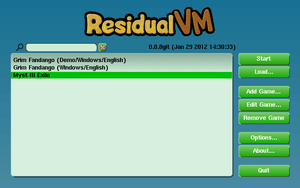ResidualVM
 | |
 | |
| Original author(s) | James Brown |
|---|---|
| Developer(s) | ResidualVM Team |
| Initial release | August 15, 2003 |
| Stable release |
0.2.1
/ January 25, 2015 |
| Written in | C++ |
| Operating system | Cross-platform |
| Type | Interpreter |
| License | GNU General Public License |
| Website |
www |
ResidualVM (formerly Residual) is a cross-platform computer program comprising 3D game engine recreations with a common graphical user interface. It supports Grim Fandango and Myst III: Exile.
ResidualVM was originally designed to play LucasArts adventure games that use the GrimE game engine.[1] On May 26, 2009, ResidualVM was adapted so that it could support multiple engines.[2] The Sprint engine from Presto Studios is now recreated in ResidualVM as well. Various other engines are in preliminary stages, but have not yet been added to the main branch. Like its sister project, the 2D adventure game interpreter ScummVM,[3] the VM in ResidualVM stands for virtual machine.
ResidualVM is a reimplementation of the part of the software used to interpret the scripting languages by conducting reverse engineering on the original game rather than emulating the hardware the games ran on. As such, ResidualVM allows the games it supports to be played on platforms other than those for which they were originally released.
Background

The name of the project comes from the fact that it was originally started to support the residual LucasArts adventure games not supported by ScummVM. The original Lua-based engine used by LucasArts in their 3D adventure games was called GrimE (as opposed to SCUMM), so ResidualVM's title is also a word pun as grime is a type of residue.
The project was started by former ScummVM team leader James Brown, and was first publicly available on August 15, 2003.[4] Progress on the project was initially slow, and as a result the project's main goal of supporting Grim Fandango did not occur until April 25, 2011, when the compatibility of Grim Fandango was upgraded to "completable with a few minor glitches".[5]
The project obtained a domain separate from ScummVM on December 6, 2011. As a result of the new domain name, the project name was changed from Residual to ResidualVM. The logo was changed to reflect the new name on January 25, 2012. The first stable release of ResidualVM was released 9 years after the project started, on December 21, 2012.[6]
ResidualVM is officially available on multiple platforms including Windows, Linux, Mac OS X, AmigaOS 4, and IRIX.[7] In addition, an Android port is available in the source code, and unofficial builds have been made with that source. There is also a port available for the Pandora console, and for FreeBSD, but they are not official as they have not been added to the main branch.
Games supported by ResidualVM
The stable release currently supports Grim Fandango[8] and Myst III: Exile, which are completable with a few minor glitches.
In the development branch, there is also support for Escape from Monkey Island,[9] which is completable with a few glitches.
Like ScummVM, ResidualVM contains fixes for bugs present in the original executable. The ResidualVM team discovered a workaround for a bug that causes a critical dialog not to play in Grim Fandango.[10][11] In addition, the Grim Fandango engine in ResidualVM has fixes for over a dozen other bugs present in the original.[12] There is also a branch of ResidualVM called Grim Mouse, which allows Grim Fandango to be played completely with a mouse as a traditional point and click adventure game.[13][14][15][16]
References
- ↑ "What If: Grim Fandango Deluxe". Rock, Paper, Shotgun. Retrieved 2012-01-13.
- ↑ "Residual extended functionality". ResidualVM. Retrieved 2012-01-29.
- ↑ "Maniac Tentacle Mindbenders: How ScummVM's unpaid coders kept adventure gaming alive". Ars Technica. Retrieved 2012-01-19.
- ↑ "ResidualVM Stable Release Supports Grim Fandango". The International House of Mojo. 2012-12-23. Retrieved 2013-01-04.
- ↑ "Sorry for the wait Mr.Flores!". ResidualVM. Retrieved 2012-01-29..
- ↑ "ResidualVM Stable Release Brings Grim Fandango to Modern PCs". The Escapist. 2012-12-21. Retrieved 2012-12-22.
- ↑ "ResidualVM 0.2.1 Bugfix Release". The International House of Mojo. 2014-02-25. Retrieved 2014-02-25.
- ↑ "Residual!". The International House of Mojo. Retrieved 2012-01-09.
- ↑ "Return of the Mojo Tidbits". The International House of Mojo. Retrieved 2012-11-13.
- ↑ "Basic Braining: Tim Schafer talks story, the 80s movies behind Psychonauts, and learning to platform". Penny Arcade Report. Archived from the original on 2012-06-22. Retrieved 2012-03-22.
- ↑ "Grim Fandango Bug Found, Fixed!". The International House of Mojo. Retrieved 2012-01-24.
- ↑ "Get Some Lumbago Lemonade With ResidualVM 0.1.1". The International House of Mojo. Retrieved 2013-01-12.
- ↑ "Mod of the Week: Mouse Interface, for Grim Fandango". PC Gamer. 2014-03-02. Retrieved 2014-06-08.
- ↑ "Fan mods Grim Fandango into point-and-click adventure". Wired. 2014-03-05. Retrieved 2014-06-08.
- ↑ "Mod Removes Grim Fandango Tank Controls, World Cheers". Rock, Paper, Shotgun. 2014-02-25. Retrieved 2014-06-08.
- ↑ "Hooray, Someone Finally Fixed Grim Fandango". Kotaku. 2014-02-23. Retrieved 2014-06-08.
External links
| Wikimedia Commons has media related to ResidualVM. |
- Official website
- Grim Fandango Deluxe - A mod project using ResidualVM